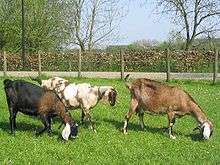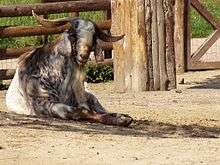Anglo-Nubian goat
 Nubian dairy does | |
| Other names | Nubian |
|---|---|
| Country of origin | Great Britain |
| Type | Dairy |
| Traits | |
| Weight |
|
| Height |
|
| |
The Anglo-Nubian is a British breed of domestic goat. It originated in nineteenth century from cross-breeding between native British goats and a mixed population of large lop-eared goats imported from India, the Middle East and North Africa.[1]:356 Its distinguishing characteristics include large, pendulous ears and a "Roman" nose. Due to their Middle-Eastern heritage, Anglo-Nubians can live in very hot climates and have a longer breeding season than other dairy goats. It has been exported to many parts of the world, and is found in more than sixty countries.[2] In many of them it is known simply as the Nubian.[2]
History
The Anglo-Nubian breed originated in England as a 1920s–1930 cross between the Old English milch goat and imported bucks,[3] including Zariby and Nubian, imported from India, Russia, and Egypt.
Breed characteristics
The typical Nubian goat is large in size and carries more flesh than other dairy breeds. The Nubian breed standard specifies large size, markings can be any colour, the ears are long, pendulous and floppy and they have a very round nose, which is referred to as a 'Roman Nose'. The Nubian temperament is sociable, outgoing, and vocal. Because of its elongated ears and sleek body, the Nubian has a variety of nicknames, including "Lop-eared Goat", "Rabbit Goat", "Long-eared Goat" and "Greyhound Goat".[4]
Anglo-Nubians are large, with does weighing at least 135 pounds (61 kg)[5] and 175 pounds (79 kg) for bucks. The minimum height of the breed, measured at the withers, is 76 centimetres (30 in) for does and 89 centimetres (35 in) for bucks.[5] Like most dairy goats, they are normally kept hornless by disbudding within approximately two weeks of birth.

Uses
The Nubian's size makes it a very useful dual purpose animal. The Nubian breed leads the way for the dairy breeds in butterfat production: it produces on average, 4.6% or more butterfat content.[6] This is surpassed only by the Nigerian Dwarf, Pygmy goat and Boer goat breeds, which are less likely to be used for large scale milk production, as for a dairy or cheesegoat.
Care
Nubians are remarkable in temperate zones of agriculture in being able to deal with temperatures as low as 0 °F (−18 °C) with open faced shelters. They readily attach to their new human owners with simple neck and side stroking. Nubians love human interaction and will call for their owner.
While being stereotyped as vocal, they are relatively quiet when provided with food, water and shelter. Just like human infants if they are making noise, they are doing so to let their needs be known. Nubians are also sometimes classified as stubborn, but Nubians are simply highly intelligent animals who know what they like and dislike. Once shown the correct way as in being let out of its pen to be milked, a Nubian will walk itself, load itself and wait to be milked.
Registries
American Dairy Goat Association (all general dairy goat breeds)
Anglo-Nubian Goat Society (Anglo-Nubian Goat Society)
Anglo-Nubian Goat photogallery (Anglo-Nubian Goat Photogallery)
References
- ↑ Valerie Porter, Lawrence Alderson, Stephen J.G. Hall, D. Phillip Sponenberg (2016). Mason's World Encyclopedia of Livestock Breeds and Breeding (sixth edition). Wallingford: CABI. ISBN 9781780647944.
- 1 2 Transboundary breed: Anglo-Nubian. Domestic Animal Diversity Information System of the Food and Agriculture Organization of the United Nations. Accessed March 2017.
- ↑ "Breeds reported by United Kingdom". Domestic Animal Diversity Information System. Food and Agriculture Organization of the United Nations. 2015. "English Goat" and "Nubian & Anglo-Nubian" entries. Retrieved 1 June 2015.
- ↑ Crowing Hill Farm Archived 14 October 2007 at the Wayback Machine.
- 1 2 Oklahoma State University Archived 9 May 2008 at the Wayback Machine.
- ↑ Oltenacu, Dr. E. A. B. "Goat Butterfat Content". www.ansci.cornell.edu. Retrieved 18 October 2014.
| Wikimedia Commons has media related to Nubian goat. |